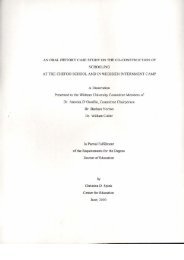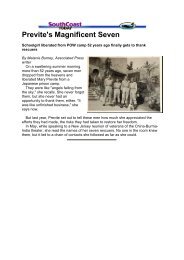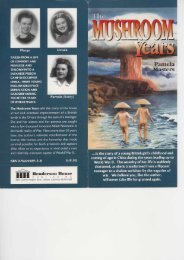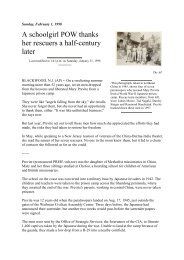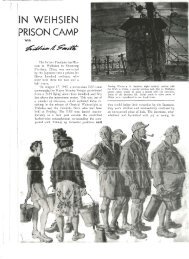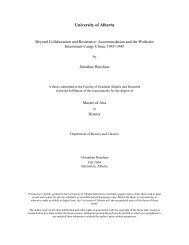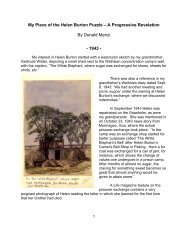The Len Mapes Story - Weihsien-Paintings
The Len Mapes Story - Weihsien-Paintings
The Len Mapes Story - Weihsien-Paintings
Create successful ePaper yourself
Turn your PDF publications into a flip-book with our unique Google optimized e-Paper software.
L eonard<br />
Those Unsung Heroes and <strong>The</strong>ir R4Ds<br />
<strong>The</strong> <strong>Len</strong> <strong>Mapes</strong> <strong>Story</strong><br />
H. “<strong>Len</strong>” <strong>Mapes</strong> grew up<br />
wanting to fly. He began at age 14<br />
and soloed at 16—on snow in a<br />
1936 Taylorcraft rigged with skis. This<br />
was not your customary first solo in a<br />
user-friendly Cessna on a 5,000-foot concrete<br />
runway. Nevertheless, <strong>Mapes</strong> was a<br />
natural.<br />
He enlisted 1 Oct. 1942, was selected<br />
for flight training and went to Naval<br />
Air Station Pensacola, Fla. Graduating<br />
from flight school near the top<br />
of his class, he was given his choice<br />
of military services and was commissioned<br />
a second lieutenant in the<br />
Marine Corps Reserve, 1 Jan. 1944.<br />
To the Pacific<br />
<strong>Mapes</strong> had dreams of following<br />
in the footsteps of fighter aces like<br />
Joe Foss and John L. Smith; however,<br />
that all-powerful administrative<br />
trump card called “needs of the service”<br />
sent him to multiengine flying.<br />
Like fellow Marine Tyrone Power of<br />
movie fame (one class behind him<br />
at Pensacola), <strong>Mapes</strong> would fly R4Ds<br />
all over the Pacific and be decorated<br />
for it.<br />
From San Diego and Camp Kearney<br />
(now Marine Corps Air Station<br />
Miramar), he was off to the war. Assigned<br />
to Marine Transport Squadron<br />
(VMR) 152, Marine Aircraft<br />
Group 25, First Marine Aircraft<br />
Wing, <strong>Mapes</strong> flew first out of New<br />
Caledonia and later from the captured airfield<br />
at Piva on Bougainville.<br />
He flew all over the Pacific theater, carrying<br />
supplies, equipment, troops and casualties<br />
into and out of battlefields from<br />
Guadalcanal and Peleliu to Samar, Leyte,<br />
Mindanao and Luzon. He used captured<br />
airfields with cratered runways, sometimes<br />
facing shot and shell. Only after the<br />
war officially ended would <strong>Mapes</strong> have<br />
his defining moment of combat, and it<br />
would be the kind of which legends are<br />
made.<br />
From Bougainville and Mindanao<br />
To China<br />
In September 1945, MAG-25 moved<br />
from Mindanao to Okinawa, then to North<br />
China. <strong>Mapes</strong> temporarily was assigned<br />
to wing headquarters in Tientsin, transport-<br />
By LtCol Tom C. McKenney, USMC (Ret) and John B. Tonkin<br />
ing senior Chinese officers, both nationalist<br />
and communist, to peace negotiations,<br />
but early October found him back with<br />
VMR-152, flying in support of the First<br />
Marine Division out of Tsankou airdrome,<br />
10 miles north of Tsingtao.<br />
It was a difficult and dangerous time of<br />
transition, with intact and armed Japanese<br />
units scattered throughout the area, some<br />
Aviation cadet <strong>Len</strong> <strong>Mapes</strong> at Pensacola, 1942, had hopes of flying<br />
fighters and downing Japanese Zeros in the Pacific. It was not to be.<br />
of whom did not believe the war was over.<br />
Ground fire was an everyday occurrence.<br />
To make the situation more dangerous,<br />
Chinese Communist forces of Mao Tsetung<br />
were advancing. <strong>The</strong> situation, especially<br />
in the contested area of North<br />
China, presented not only volatile diplomatic<br />
challenges, but at times resulted in<br />
armed confrontations with the Japanese<br />
and brief but deadly engagements with<br />
the communists.<br />
According to historian and author<br />
Robert Sherrod, MAG-25’s two transport<br />
squadrons, VMR-152 and -153, provided<br />
“the only kind of reliable transport in<br />
China.”<br />
In addition, the situation was a political<br />
minefield with hot wires leading back to<br />
the White House. A Marine Corps presence<br />
in North China was not just volatile<br />
and dangerous; in terms of its political<br />
implications, it was downright nuclear.<br />
MAG-25 to the Rescue<br />
One of the most commendable yet leastknown<br />
chapters in Marine Corps history<br />
took place in North China and Manchuria<br />
in the late summer and autumn of 1945,<br />
when MAG-25 and its R4Ds, along with<br />
the Army Air Corps and the Office<br />
of Strategic Services (OSS), participated<br />
in the rescue and evacuation<br />
of Allied civilians from Japanese<br />
prison camps. Those missions were<br />
made more difficult by the Chinese<br />
Communist and Japanese forces resisting<br />
the rescue operations at times.<br />
Preparation for the Rescue<br />
<strong>The</strong> liberation began with an OSS<br />
team, inserted by parachute, to create<br />
an American military presence<br />
and take possession of the prisoners.<br />
<strong>The</strong>y laid the groundwork for liberation.<br />
Leaflet drops usually followed,<br />
notifying the prisoners that<br />
food and clothing would be dropped<br />
soon and cautions about what and<br />
how much the prisoners should eat.<br />
By that time the prisoners were<br />
starving. <strong>The</strong> average man had lost<br />
100 pounds, and many were walking<br />
skeletons. Some children’s teeth<br />
had grown in, but without enamel.<br />
After the leaflets, parachutes containing<br />
food and medicine followed.<br />
Next, a small group of officers were<br />
flown in to make arrangements for the<br />
prisoners’ evacuation by train or aircraft.<br />
<strong>The</strong> food, medicine and clothing drops<br />
greatly improved the condition of the prisoners,<br />
with even their ragged clothing replaced.<br />
One survivor, who was 12 at the<br />
time, remembers that soon “men, women,<br />
and children were wearing khaki clothing,<br />
including underwear.”<br />
To the Rescue<br />
From October through December 1945,<br />
<strong>Mapes</strong> flew in support of Marine operations<br />
in North China, including 17 missions<br />
to rescue civilians in the prison<br />
camps. Because the R4D could carry only<br />
18 to 20 evacuees, the flight crew on rescue<br />
missions typically consisted of just<br />
pilot and copilot. When armed resistance<br />
28 LEATHERNECK JUNE 2011 www.mca-marines.org/leatherneck<br />
COURTESY OF MAJ LEN MAPES
Assisted by two Army paratroopers and two Marine officers,<strong>Weihsien</strong> evacuees, dressed in a mixture of Army, Navy and Marine uniform items plus a few personal<br />
possessions that survived more than four years captivity, board a MAG-25 R4D in October 1945.<br />
was likely, extra weapons and sharpshooters<br />
were taken along. <strong>The</strong> sharpshooters<br />
were combat veterans provided by security<br />
units in Tsingtao. Of the 17 rescue<br />
missions <strong>Mapes</strong> flew, the one to the camp<br />
at <strong>Weihsien</strong> was unforgettable.<br />
One Hero’s Sacrifice<br />
One prisoner at <strong>Weihsien</strong> was “the Flying<br />
Scotsman,” Eric Liddell, legendary<br />
Olympic gold medalist and missionary.<br />
Liddell gained fame during the 1924<br />
Olympics by refusing to run on Sunday<br />
in an event he was sure to win, a story<br />
portrayed in the movie “Chariots of Fire.”<br />
A greatly respected leader, teacher and<br />
organizer of athletics in the camp, “Uncle<br />
Eric” died before the rescue teams arrived.<br />
When he became very ill from a<br />
brain tumor, the Japanese offered to set<br />
him free to find his own medical care. He<br />
might have lived, but he insisted that a<br />
pregnant woman be released in his place.<br />
His remains lie buried at <strong>Weihsien</strong>.<br />
Complications at <strong>Weihsien</strong><br />
Only one railroad evacuation from<br />
<strong>Weihsien</strong> was made before the Chinese<br />
Communists resumed destruction of the<br />
tracks. It soon became obvious that evacuations<br />
by rail would not be feasible. <strong>The</strong><br />
remaining 1,500 prisoners at <strong>Weihsien</strong><br />
would have to be taken out by air.<br />
<strong>The</strong> airfield at <strong>Weihsien</strong> was garrisoned<br />
by a Japanese army unit still not convinced<br />
that the war was over. Even after the sevenman<br />
OSS team, led by Army Major Stanley<br />
Staiger, took nominal possession of<br />
the camp, an Army B-24 met opposition.<br />
As the B-24 approached the runway, the<br />
Japanese garrison went to battle stations,<br />
manned their guns and prepared to open<br />
fire. <strong>The</strong> B-24 wisely departed. A furious<br />
MAJ Staiger confronted the Japanese<br />
commander, but the situation at <strong>Weihsien</strong><br />
continued to be unpredictable and explosive.<br />
Nearby, a Chinese Communist garrison<br />
was anxious also to take control of<br />
the area, its airfield and railroad station.<br />
On 12 Oct., the first R4D of MAG-25<br />
landed at <strong>Weihsien</strong> to evacuate prisoners.<br />
Eight days later, the camp was empty. But<br />
the process wasn’t peaceful.<br />
A Mission to be Remembered<br />
Among the prisoners at <strong>Weihsien</strong> was a<br />
72-year-old White Russian of distinguished<br />
background. She might have<br />
been a countess, related to the late Czarina<br />
Alexandra, wife of Czar Nicholas.<br />
Her husband was a Romanov, related to the<br />
late czar. She would have had enormous<br />
propaganda value to the Chinese Communists,<br />
who were aware of her presence.<br />
Lt <strong>Mapes</strong> was briefed about her presence<br />
and that the Chinese Communists might<br />
take her, and the team was prepared. Sharpshooters<br />
were stationed at open windows,<br />
instructed to open fire on the Chinese the<br />
moment a shot was fired by anyone.<br />
Into <strong>Weihsien</strong><br />
<strong>Mapes</strong> landed at <strong>Weihsien</strong> without opposition<br />
and taxied to the loading area.<br />
<strong>The</strong> prisoners had been trucked to the airfield,<br />
and when the R4D rolled up and<br />
stopped, they were ready.<br />
Leaving the copilot at the controls with<br />
one engine running and the brakes on,<br />
<strong>Mapes</strong> climbed down to supervise the<br />
loading of the prisoners as the sharpshooters<br />
took up firing positions. <strong>The</strong><br />
prisoners climbed aboard on the fold-out<br />
ladder, and the loading was accomplished<br />
smoothly. <strong>The</strong> starboard engine continued<br />
to run at a fast idle, with the R4D straining<br />
against the brakes.<br />
www.mca-marines.org/leatherneck JUNE 2011 LEATHERNECK 29<br />
COURTESY OF GREG LECK/NARA
Above: Evacuees from the <strong>Weihsien</strong> camp assemble at the airfield as a MAG-25 R4D approaches, October 1945. (Photo courtesy of Greg Leck/NARA)<br />
Below: LtCol Louis Metzger (center, right) explains the evacuation process to prisoners at <strong>Weihsien</strong> as Maj Henry Sabatier (to Metzger’s left with leather strap<br />
around his shoulder) and an unidentified MAG-25 pilot stand by to assist. (Photo courtesy of Greg Leck/NARA)
“I Will Have the Countess”<br />
As the last prisoners were being seated,<br />
a Chinese Communist colonel arrived with<br />
an escort of soldiers. With an air of belligerent<br />
authority, he announced that he<br />
would take possession of “the countess.”<br />
<strong>The</strong> sharpshooters were at the ready, their<br />
M1s locked and loaded. To fire they had<br />
only to push the safety forward with their<br />
trigger fingers and squeeze. <strong>The</strong> colonel’s<br />
escort stood at order arms.<br />
<strong>Mapes</strong>’ reply could not be misunderstood,<br />
no matter what the language, and<br />
the colonel seemed to expect that negative<br />
reply. Without another word, his hand<br />
moved toward his pistol and opened the<br />
holster flap. <strong>Mapes</strong> instinctively drew his<br />
.38 from its shoulder holster. In one uninterrupted<br />
motion, before the colonel’s<br />
pistol cleared its holster, <strong>Mapes</strong> shot the<br />
colonel in the forehead.<br />
<strong>The</strong>re was no turning back. With that<br />
first shot, the Marine sharpshooters opened<br />
a fusillade on the colonel’s escort. Shocked<br />
at what they were seeing, the Chinese soldiers<br />
hesitated, and most were down before<br />
they could bring their rifles to the<br />
ready. It happened in a matter of seconds.<br />
“A Little Too Quick on the Throttles”<br />
When the firing began, the copilot started<br />
the port engine, released the brakes and<br />
eased the throttles forward. <strong>The</strong> Chinese<br />
were not all dead and fired a few ineffective<br />
rounds as <strong>Mapes</strong> sprinted after the<br />
R4D. He caught the trailing edge of the<br />
fold-out ladder, skipped along as the R4D<br />
picked up speed and, with help from the<br />
sharpshooters, scrambled through the open<br />
door. As he caught his breath, the aircraft<br />
lifted off the runway.<br />
<strong>Mapes</strong> and the sharpshooters pulled in<br />
the ladder and closed and secured the door.<br />
He then went forward and settled into his<br />
seat as the R4D’s 1,200-horsepower engines<br />
roared, clawing for altitude at maximum<br />
power, climbing away toward safety.<br />
<strong>Mapes</strong> made a climbing, wide left turn,<br />
set a course for Tsingtao and chastised<br />
the copilot (“he was a little too quick on<br />
the throttles”). Everyone began to relax.<br />
It had been quite a day, but they had taken<br />
no casualties. <strong>The</strong>y were headed for home,<br />
and the prisoners were free.<br />
Great Work That Never Happened<br />
Although there were free drinks and<br />
backslapping in the officers’ club back at<br />
Tsingtao, the rescue of the prisoners, including<br />
the distinguished Russian, without<br />
taking a casualty, was one of those exceptional<br />
accomplishments covertly appreciated,<br />
but never recognized officially. <strong>The</strong><br />
incident had the potential to produce a<br />
political hurricane. For that reason, <strong>Mapes</strong><br />
never would be decorated for the rescue<br />
This leaflet, notifying the prisoners of Japan’s surrender, and of airdropped supplies and evacuation to<br />
come, was airdropped on the <strong>Weihsien</strong> camp, August 1945.<br />
or have it mentioned in his fitness report.<br />
He was, however, decorated with the Breast<br />
Order of the Cloud and Banner by Chiang<br />
Kai-shek; he even was kissed on the cheek<br />
by Madame Chiang.<br />
An indication of the award’s other-thanroutine<br />
nature is that the citation was not<br />
cleared by Headquarters, U.S. Marine<br />
Corps for presentation to <strong>Mapes</strong> until August<br />
1948, 2½ years after presentation of<br />
the medal in China. Even then, Headquarters<br />
Marine Corps had second thoughts;<br />
two months after receiving the citation,<br />
<strong>Mapes</strong> was ordered to return it to the<br />
Commandant. It finally was returned in<br />
1949 after careful parsing and perhaps<br />
some redaction of the Chinese wording.<br />
Almost four years after receiving the<br />
medal, <strong>Mapes</strong> finally had the citation.<br />
<strong>The</strong> Years That Followed<br />
In January 1946, <strong>Mapes</strong> was transferred<br />
from MAG-25 to Headquarters, Department<br />
of the Pacific at Tsingtao, awaiting<br />
transportation. On 2 Feb., he left the war<br />
and North China astern, in the wake of<br />
USS Seminole (AKA-104). In the States,<br />
he was promoted to first lieutenant and<br />
released from active duty on 25 April<br />
1946. He would return to active duty for<br />
the Korean War and retire as a major,<br />
USMCR, on 1 Dec. 1966.<br />
Now 89, <strong>Mapes</strong> lives with his wife,<br />
Dora, outside of Lebanon, Ohio. <strong>The</strong> controversial<br />
Chinese citation hangs on his<br />
wall, reminding an old Marine of one longago<br />
day: the day he saved a distinguished<br />
lady in North China from a cruel imprisonment,<br />
public humiliation and death.<br />
Authors’note: No official record of the<br />
details of this particular mission is available;<br />
this account is based on Maj <strong>Mapes</strong>’<br />
recollections, which remain vivid after<br />
more than 65 years.<br />
Editor’s note: LtCol McKenney enlisted<br />
in 1949, was commissioned in 1953 and<br />
was retired in 1971 for disability incurred<br />
in Vietnam. He contributed “Yemassee,<br />
Gateway to the Corps” for the March<br />
2008 Leatherneck. Former Cpl Tonkin<br />
enlisted in 1955 and is a retired labor-relations<br />
executive. He and LtCol McKenney<br />
served together at Marine Barracks<br />
Clarksville, Tenn., in the late 1950s under<br />
the command of the legendary Col Walter<br />
Walsh.<br />
www.mca-marines.org/leatherneck JUNE 2011 LEATHERNECK 31<br />
COURTESY OF GREG LECK/NARA



